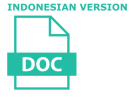Pemerolehan Kosakata Dalam Bahasa Jepang Melalui Pengajaran Bunpoo Dan Kaiwa
Made Ratna Dian Aryani(1*)
(1) Udayana Univesity
(*) Corresponding Author
Abstract
The focus of this article is vocabulary acquisition of Japanese through demonstrative methods. This article is the result of research on the methods of vocabulary acquisition of Nursing Science students of Faculty of Medicine, Universitas Udayana. This article aims to explain the use of language teaching methods and strategies in non-language classes. The method used in this research is descriptive qualitative method. This article refers to the concept and theories formulated by Bandura (1986). Natural methods are used in learning Japanese grammar. Vocabulary acquisition can be obtained through the explanation of simple vocabularies that is started from a classroom environment, or through the dictionary used in the study. While, in conversation learning, the methods used are shadowing method and conversation method, which is supported by demonstrative strategies and the “question and answer” strategy. The strategy is employed by providing similar questions to all of the learners that make them try to look for different vocabularies to answer the question. The demonstrative strategy is used for observation, imitation and repetition, as well as development of the material of the context in real life situations.
Keywords
Full Text:
PDFReferences
Bandura, A. (1986). Social Learning Through Imitation. Jones, Marshall R. (Ed), (1962). Nebraska Symposiun on Motivation, 1962., (pp. 211-274). Oxford, England: Univer. Nebraska Press, xiii, 330 pp.
---------------------. (2001). Sosial Cognitive Theory: An Agentic Perspective Annual Review of Psychology. Vol. 52: 1-26. California: Stanford University
Benner, David G. (1985). Encyclopedia of Psychology. Grand Rapids: Baker Book House. h. 98
Boeree, C. (2008). Personality Theories: Melacak Kepribadian Anda Bersama Psikolog Dunia. Yogyakarta: Prismasophie. h. 240
Chino, N. (1996). Partikel Penting Bahasa Jepang. Jakarta: Kesaint Blanc.
Clark, H. H. dan Clark, E.V. (1977). Psychology and Language. New York: Harcourt Brace Javanovich,Inc.
Iwasaki, S. (1999). Japanese. Tokyo: John Benyamins Publising Company
Johnson, M. (2004). A Philosophy of Second Language Acquisition. New Haven, CT: Yale University Press
Krashen, S. (2003). Explorations in Language Acquisition and Use: The Taipei Lectures. Portmouth, NH: Heinemann.
Long, M. H. (1996). The Role of the Linguistic Enviroment in Second Language Acquisition In Handbook of Second Language Acquisition,ed. W.C. Ritchie and T. K. Bhatia, 413-468. New York: Academic Press.
Piaget, J. (1995). Sociological Studies. London: Routledge.
Tim Penyunting Japan Foundation. (2017). Marugoto Bahasa dan Kebudayaan Jepang: Tingkat Dasar 1 A1: Aktivitas. Kajarta: Kasaint Blanc.
Tim Penyunting Japan Foundation. (2017). Marugoto Bahasa dan Kebudayaan Jepang: Tingkat Dasar 1 A1: Pemahaman. Kajarta: Kasaint Blanc.
Tim Penyusun Dosen Sastra Jepang Fakultas Ilmu Budaya Universitas Udayana. 2015. Pengajaran Bahasa Jepang Untuk Program Studi Ilmu Keperawatan: Universitas Udayana
Article Metrics
Refbacks
- There are currently no refbacks.
Copyright (c) 2018 The Author(s)

This work is licensed under a Creative Commons Attribution-ShareAlike 4.0 International License.







